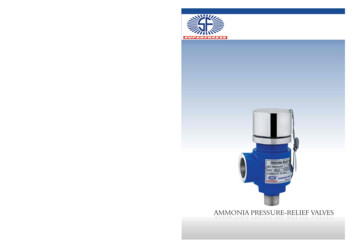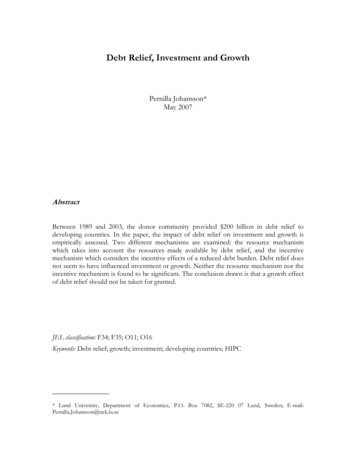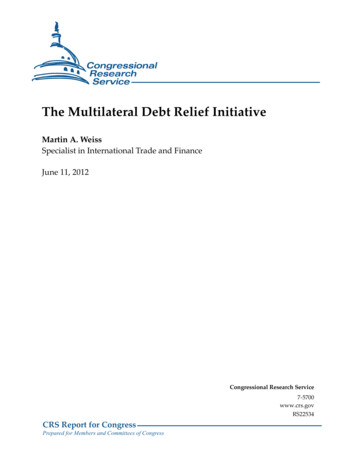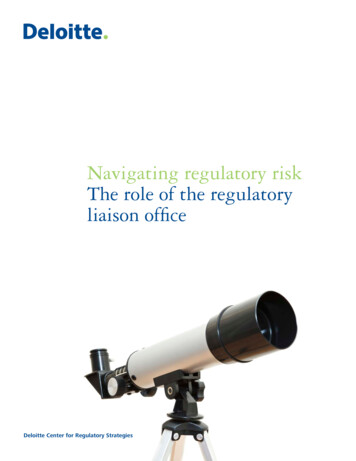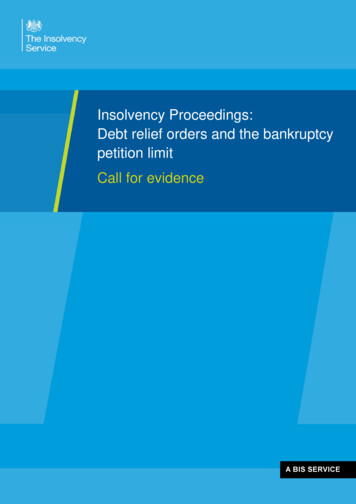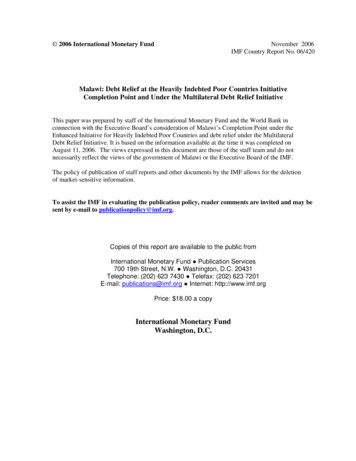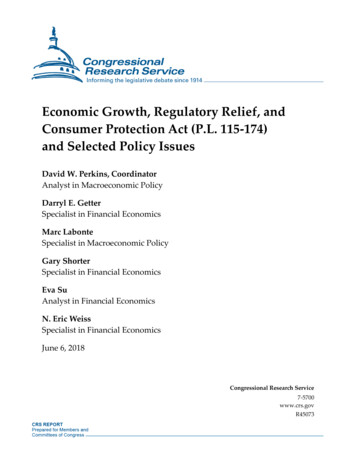
Transcription
Economic Growth, Regulatory Relief, andConsumer Protection Act (P.L. 115-174)and Selected Policy IssuesDavid W. Perkins, CoordinatorAnalyst in Macroeconomic PolicyDarryl E. GetterSpecialist in Financial EconomicsMarc LabonteSpecialist in Macroeconomic PolicyGary ShorterSpecialist in Financial EconomicsEva SuAnalyst in Financial EconomicsN. Eric WeissSpecialist in Financial EconomicsJune 6, 2018Congressional Research Service7-5700www.crs.govR45073
Economic Growth, Regulatory Relief, and Consumer Protection Act (P.L. 115-174)SummarySome observers assert the financial crisis of 2007-2009 revealed that excessive risk had built upin the financial system, and that weaknesses in regulation contributed to that buildup and theresultant instability. In response, Congress passed the Dodd-Frank Wall Street Reform andConsumer Protection Act (P.L. 111-203; the Dodd-Frank Act), and regulators strengthened rulesunder existing authority. Following this broad overhaul of financial regulation, some observersargue certain changes are an overcorrection, resulting in unduly burdensome regulation.The Economic Growth, Regulatory Relief, and Consumer Protection Act (S. 2155, P.L. 115-174)was signed into law by President Donald Trump on May 24, 2018. P.L. 115-174 modifies DoddFrank provisions, such as the Volcker Rule (a ban on proprietary trading and certain relationshipswith investment funds), the qualified mortgage criteria under the Ability-to-Repay Rule, andenhanced regulation for large banks; provides smaller banks with an “off ramp” from Basel IIIcapital requirements—standards agreed to by national bank regulators as part of an internationalbank regulatory framework; and makes other changes to the regulatory system.Most changes made by P.L. 115-174 can be grouped into one of five issue areas: (1) mortgagelending, (2) regulatory relief for “community” banks, (3) consumer protection, (4) regulatoryrelief for large banks, and (5) regulatory relief for capital formation.Title I of P.L. 115-174 relaxes or provides exemptions to certain mortgage lending rules. Forexample, it creates a new compliance option for mortgages originated and held by banks andcredit unions with less than 10 billion in assets to be considered qualified mortgages for thepurposes of the Ability-to-Repay Rule. In addition, P.L. 115-174 exempts certain insureddepositories and credit unions that originate few mortgages from certain Home MortgageDisclosure Act reporting requirements.A number of Title II provisions provide regulatory relief to community banks. For example, bankswith under 10 billion in assets are exempt from the Volcker Rule, and certain banks that meet anew Community Bank Leverage Ratio are exempt from other risk-based capital ratio and leverageratio requirements.Title III enhances consumer protections in targeted areas. For example, it subjects credit reportingagencies (CRAs) to additional requirements, including requirements to generally provide fraudalerts for consumer files for at least a year and to allow consumers to place security freezes ontheir credit reports. In addition, it requires CRAs to exclude certain medical debt from veterans’credit reports.Title IV alters the criteria used to determine which banks are subject to enhanced prudentialregulation from the original 50 billion asset threshold original set by Dodd-Frank. Banksdesignated as global systemically important banks and banks with more than 250 billion inassets are still automatically subjected to enhanced regulation. However, under P.L. 115-174banks with between 100 billion and 250 billion in assets are automatically subject only tosupervisory stress tests, while the Federal Reserve (Fed) has discretion to apply other individualenhanced prudential provisions to these banks. Banks with assets between 50 billion and 100billion will no longer be subject to enhanced regulation, except for the risk committeerequirement. In addition, P.L. 115-174 relaxes leverage requirements for large custody banks, andallows certain municipal bonds to be counted toward large banks’ liquidity requirements.Title V provides regulatory relief to certain securities regulations to encourage capital formation.For example, it exempts more securities exchanges from state securities regulation and subjectscertain investment pools to fewer registration and disclosure requirements.Congressional Research Service
Economic Growth, Regulatory Relief, and Consumer Protection Act (P.L. 115-174)Title VI provides enhanced consumer protection for borrowers of student loans. For example, itrequires CRA to exclude certain defaulted private student loan debt from credit reports.Proponents of P.L. 115-174 assert it provides necessary and targeted regulatory relief, fosterseconomic growth, and provides increased consumer protections. Opponents of the legislationargue it needlessly pares back important Dodd-Frank protections to the benefit of large andprofitable banks.Congressional Research Service
Economic Growth, Regulatory Relief, and Consumer Protection Act (P.L. 115-174)ContentsIntroduction . 1Amending Mortgage Rules. 2Background . 3Provisions and Selected Analysis . 5Section 101—Qualified Mortgage Status for Loans Held by Small Banks . 5Section 102—Charitable Tax Deduction for Appraisals . 7Section 103—Exemption from Appraisals in Rural Areas . 8Section 104—Home Mortgage Disclosure Act Adjustment . 8Section 105—Credit Union Loans for Nonprimary Residences . 9Section 106—Mortgage Loan Originator Licensing and Registration . 9Section 107—Manufactured Homes Retailers . 10Section 108—Escrow Requirements Relating to Certain ConsumerCredit Transactions . 10Section 109—Waiting Period Requirement for Lower-Rate Mortgage . 11Regulatory Relief for Community Banks . 12Background . 12Provisions and Selected Analysis . 14Section 201—Community Bank Leverage Ratio. 14Section 202—Allowing More Banks to Accept Reciprocal Deposits . 16Section 203 and 204—Changes to the Volcker Rule . 16Section 205—Financial Reporting Requirements for Small Banks . 18Section 206—Allowing Thrifts to Opt-In to National Bank Regulatory Regime. 18Section 207—Small Bank Holding Company Policy Statement Threshold . 19Section 210—Frequency of Examination for Small Banks . 19Section 213—Identification When Opening an Account Online . 20Section 214—Classifying High Volatility Commercial Real Estate Loans . 20Consumer Protections. 20Background . 21Credit Reporting . 21Veterans and Active Duty Servicemembers . 22Student Loans . 23Provisions and Selected Analysis . 23Section 215—Reducing Identity Theft . 23Section 301—Fraud Alerts and Credit Report Security Freezes . 24Section 302—Veteran Medical Debt in Credit Reports . 25Section 303—Whistleblowers on Senior Exploitation . 25Section 304—Protecting Tenants at Foreclosure . 26Section 307—Real Property Retrofit Loans . 26Section 309—Protecting Veterans from Harmful Mortgage Refinancing . 26Section 310—Consider Use of Alternative Credit Scores for MortgageUnderwriting . 27Section 313—Foreclosure Relief Extension for Servicemembers . 27Section 601—Student Loan Protections in the Event of Death or Bankruptcy . 28Section 602—Certain Student Loan Debt in Credit Reports . 28Regulatory Relief for Large Banks . 29Background . 29Congressional Research Service
Economic Growth, Regulatory Relief, and Consumer Protection Act (P.L. 115-174)Provisions and Selected Analysis . 32Section 401—Enhanced Prudential Regulation and the 50 Billion Threshold . 32Section 402—Custody Banks and the Supplementary Leverage Ratio . 36Section 403—Municipal Bonds and Liquidity Coverage Ratio . 38Capital Formation . 38Background . 39Provisions and Selected Analysis . 40Section 501—National Security Exchange Parity . 40Section 504—Registration Requirements for Small Venture Capital Funds . 40Section 506—U.S. Territories Investor Protection. 41Section 507—Disclosure Requirements for Companies Paying Personnel in Stock . 42Section 508―Expanding Regulation A Access to Reporting Companies . 42Section 509—Streamlined Closed-End Fund Registration . 43Miscellaneous Proposals in P.L. 115-174 . 44FiguresFigure 1. House Prices, 1991-2017 . 3Figure 2. Mortgage Originations by Credit Score . 5TablesTable 1. Comparison of P.L. 115-174 to the CFPB’s Small Creditor Portfolio QM . 7Table 2. BHCs and IHCs with Over 50 Billion in Assets . 33Table A-1. Asset Size and Other Thresholds in P.L. 115-174 . 46Table B-1. Policy Issues Addressed in P.L. 115-174 and Selected House Legislation . 48AppendixesAppendix A. Asset Size and Other Thresholds in P.L. 115-174 . 46Appendix B. Similar Policy Issues in Selected House Bills. 48ContactsAuthor Contact Information . 50Congressional Research Service
Economic Growth, Regulatory Relief, and Consumer Protection Act (P.L. 115-174)IntroductionThe Economic Growth, Regulatory Relief, and Consumer Protection Act (S. 2155) was reportedout by the Senate Committee on Banking, Housing, and Urban Affairs on December 18, 2017. Itwas then passed by the Senate on March 14, 2018, following the inclusion of a manager’samendment that added a number of provisions to the bill as reported.1 The House passed P.L. 115174 on May 22, 2018, and President Donald Trump signed it into law on May 24, 2018.P.L. 115-174 changes a number of financial regulations; its six titles alter certain aspects of theregulation of banks, capital markets, mortgage lending, and credit reporting agencies. Many ofthe provisions can be categorized as providing regulatory relief to banks and certain companiesaccessing capital markets. Others are designed to relax mortgage lending rules and provideadditional protections to consumers, including protections related to credit reporting, veterans’mortgage refinancing, and student loans.Some P.L. 115-174 provisions amend the Dodd-Frank Wall Street Reform and ConsumerProtection Act (Dodd-Frank Act; P.L. 111-203), regulatory reform legislation enacted followingthe 2007-2009 financial crisis that initiated the largest change to the financial regulatory systemsince at least 1999.2 Other provisions amend certain rules implemented by bank regulators underexisting authorities and which closely adhere to the Basel III Accords—the international bankregulation standards-setting agreement. Finally, other provisions address long-standing or morerecent issues not directly related to Dodd-Frank or Basel III.Proponents of the legislation assert it provides targeted financial regulatory relief that eliminates anumber of unduly burdensome regulations, fosters economic growth, and strengthens consumerprotections.3 Opponents of the legislation argue it needlessly pares back important Dodd-Franksafeguards and protections to the benefit of large and profitable banks.4Prior to passage of P.L. 115-174, the House and the Administration had also proposed wideranging financial regulatory relief plans. In terms of the policy areas addressed, some of thechanges in P.L. 115-174 are similar to those proposed in the Financial CHOICE Act (FCA; H.R.10), which passed the House on June 8, 2017 (see Appendix B).5 However, the two billsgenerally differ in the scope and degree of proposed regulatory relief. The FCA calls forwidespread changes to the regulatory framework across the entire financial system, whereas P.L.115-174 is more focused on the banking industry, mortgages, capital formation, and creditreporting. Likewise, many of the provisions found in P.L. 115-174 parallel regulatory reliefrecommendations made in the Treasury Department’s series of reports pursuant to ExecutiveOrder 13772, particularly the first report on banks and credit unions.6 The Treasury reports are1Previous versions of this report examined S. 2155, as reported. This updated version of the report examines P.L. 115174, as passed by the Senate and House and signed into law by the President.2For more information, see CRS Report R41350, The Dodd-Frank Wall Street Reform and Consumer Protection Act:Background and Summary, coordinated by Baird Webel.3Senate Committee on Banking, Housing, and Urban Affairs, “Senators Announce Agreement on Economic GrowthLegislation,” majority press release, November 13, 2017, at publican-press-releases.4Senate Committee on Banking, Housing, and Urban Affairs, “Brown Opposes Legislation to Roll Back Dodd-FrankProtections,” minority press release, November 13, 2017, at mocratic-press-releases.5For more information, see CRS Report R44839, The Financial CHOICE Act in the 115th Congress: Selected PolicyIssues, by Marc Labonte et al.6U.S. Department of the Treasury, A Financial System That Creates Opportunities: Banks and Credit Unions, June(continued.)Congressional Research Service1
Economic Growth, Regulatory Relief, and Consumer Protection Act (P.L. 115-174)more wide-ranging than P.L. 115-174, however, and more focused on changes that can be madeby regulators without congressional action.The Congressional Budget Office (CBO) estimated that P.L. 115-174 would reduce the budgetdeficit by 23 million over 10 years.7 CBO estimated that only one provision would reduce thedeficit—Section 217 requires the Federal Reserve (Fed) to transfer 675 million from its surplusaccount to the Treasury, where it is added to general revenues. CBO estimated that this provisionwould increase revenues by 478 million on net over 10 years.8 CBO assumed when making theestimate that the Fed would finance the transfer by selling Treasury securities, which otherwisewould have earned 177 million in income that would have been remitted to the Treasury in thenext 10 years. Thus, the provision can be thought of as shifting Fed remittances from the future tothe present, as opposed to representing new economic resources available to the federalgovernment. Various other provisions are forecast to increase the deficit, with the three provisionswith the largest effect on the deficit being the community bank leverage ratio (Section 201),changes to the enhanced regulation threshold (Section 401), and changes to the supplementaryleverage ratio for custody banks (Section 402).9This report summarizes P.L. 115-174 as enacted and highlights major policy proposals of thelegislation. Most changes proposed by P.L. 115-174, as passed, can be grouped into one of fiveissue areas: (1) mortgage lending, (2) regulatory relief for “community” banks, (3) consumerprotection, (4) regulatory relief for large banks, and (5) regulatory relief in securities markets. Thereport provides background on each policy area, describes the P.L. 115-174 provisions that makechanges in these areas, and examines the prominent policy issues related to those changes. In itsfinal section, this report also provides an overview of provisions that do not necessarily relatedirectly to these five topics. This report also includes a contact list of CRS experts on topicsaddressed by P.L. 115-174, a summary of various exemption thresholds created or raised by P.L.115-174 in Appendix A, and a list of provisions in P.L. 115-174 that address similar issues as anumber of House bills in Appendix B.Amending Mortgage RulesTitle I of P.L. 115-174 is intended to reduce the regulatory burden involved in mortgage lendingand to expand credit availability, especially in certain market segments. Following the financialcrisis, in which lax mortgage standards are believed by certain observers to have played a role,new mortgage regulations were implemented and some existing regulations were strengthened.Some analysts are now concerned that certain new and long-standing regulations unduly impedethe mortgage process and unnecessarily restrict the availability of mortgages. To address theseconcerns, several provisions in P.L. 115-174 are designed to relax mortgage rules, including by(.continued)2017, at es/Documents/A%20Financial%20System.pdf. For asummary, see CRS Insight IN10720, First Treasury Report on Regulatory Relief: Depository Institutions, by David W.Perkins.7Congressional Budget Office, Estimates of the Direct Spending and Revenue Effects of Amendment Number 2151,March 8, 2018, at 8Congressional Budget Office, Estimates of the Direct Spending and Revenue Effects of Amendment Number 2151,March 8, 2018, at 9Congressional Budget Office, Cost Estimate, P.L. 115-174, March 5, 2018, at 17-2018/costestimate/s2155.pdf.Congressional Research Service2
Economic Growth, Regulatory Relief, and Consumer Protection Act (P.L. 115-174)providing relief to small lenders and easing rules related to specific mortgage types or markets.Other analysts argue that market developments have contributed to a tightening of mortgagecredit and, though some changes to regulations may be desirable, the regulatory structure in placeprior to the enactment of P.L. 115-174 generally provided important consumer protections.Background10The bursting of the housing bubble in 2007 preceded the December 2007-June 2009 recessionand a financial panic in September 2008. As shown in Figure 1, house prices rose significantlybetween 1991 and 2007 and then declined sharply for several years. Nationwide house prices didnot return to their peak levels until the end of 2015. The decrease in house prices reducedhousehold wealth and resulted in a surge in foreclosures. This had negative effects onhomeowners and contributed to the financial crisis by straining the balance sheets of financialfirms that held nonperforming mortgage products.Figure 1. House Prices, 1991-2017Source: Figure created by CRS using data from the Federal Housing Finance Agency House Price Index(Seasonally Adjusted Purchase-Only Index).Note: January 1991 is set to 100 for this index.Many factors contributed to the housing bubble and its collapse, and there is significant debateabout the underlying causes even a decade later. Many observers, however, point to relaxedmortgage underwriting standards, an expansion of nontraditional mortgage products, andmisaligned incentives among various participants as underlying causes.11Mortgage lending has long been subject to regulations intended to protect homeowners and toprevent risky loans, but the issues evident in the financial crisis spurred calls for reform. TheDodd-Frank Act made a number of changes to the mortgage system, including establishing theConsumer Financial Protection Bureau (CFPB)12—which consolidated many existing authorities10For more information, see CRS In Focus IF10126, Introduction to Financial Services: The Housing Finance System,by Katie Jones and N. Eric Weiss.11The Financial Crisis Inquiry Commission, The Financial Crisis Inquiry Report, January 2011, pp. /GPO-FCIC.pdf.12P.L. 111-203 Title X.Congressional Research Service3
Economic Growth, Regulatory Relief, and Consumer Protection Act (P.L. 115-174)and established new authorities, some of which pertained to the mortgage market—and creatingnumerous consumer protections in Dodd-Frank’s Title XIV, which was called the MortgageReform and Anti-Predatory Lending Act.13A long-standing issue in the regulation of mortgages and other consumer financial services is theperceived trade-off between consumer protection and credit availability. If regulation intended toprotect consumers increases the cost of providing a financial product, some lenders may charge ahigher price and provide the service more selectively.14 Those who still receive the product maybenefit from the enhanced disclosure or added legal protections of the regulation, but that benefitmay result in a higher price for the product.Some policymakers generally believe that the postcrisis mortgage rules have struck theappropriate balance between protecting consumers and ensuring that credit availability is notrestricted due to overly burdensome regulations. They contend that the regulations are intended toprevent those unable to repay their loans from receiving credit and have been appropriatelytailored to ensure that those who can repay are able to receive credit.15Critics counter that some rules have imposed compliance costs on lenders of all sizes, resulting inless credit available to consumers and restricting the types of products available to them. Someassert this is especially true for certain nonstandard types of mortgages, such as mortgages forhomes in rural areas or for manufactured housing. They further argue that the rules for certaintypes of lenders, usually small lenders, are unduly burdensome.16A variety of experts and organizations attempt to measure the availability of mortgage credit, andalthough their methods vary, it is generally agreed that mortgage credit is tighter than it was in theyears prior to the housing bubble and subsequent housing market turmoil. Figure 2 shows thatmortgage originations to borrowers with FICO credit scores below 720 have decreased inabsolute and percentage terms. However, no consensus exists on whether or to what degreemortgage rules have unduly restricted the availability of mortgages, in part because it is difficultto isolate the effects of rules and the effects of broader economic and market forces. For example,the supply of homes on the market, demand for those homes, and demographic trends may also beplaying a role.17 In addition, whether a tightening of credit should be interpreted as a desirablecorrection to precrisis excesses or an unnecessary restriction on credit availability is subject todebate.13P.L. 11-203 Title XIV.House Financial Services Committee, The Financial CHOICE Act, A Republican Proposal to Reform The FinancialRegulatory System, April 24, 2017, pp. 6-7, 51-52.15H.Rept. 115-153, Part 1, Book 2, “Minority View,” pp. 968-971.16House Financial Services Committee, The Financial CHOICE Act, A Republican Proposal to Reform The FinancialRegulatory System, April 24, 2017, pp. 6-7, 51-52.17For example, see Joint Center for Housing Studies, The State of the Nation’s Housing 2015, pp. 8-9.14Congressional Research Service4
Economic Growth, Regulatory Relief, and Consumer Protection Act (P.L. 115-174)Figure 2. Mortgage Originations by Credit ScoreSource: Federal Reserve Bank of New York, Quarterly Report on Household Debt and Credit, 2017 Q3, p. 6, ives/householdcredit/data/pdf/HHDC 2017Q3.pdf.Provisions and Selected AnalysisTitle I contains 10 sections that amend various laws that affect relatively small segments of thenation’s mortgage market. Some sections pertain to consumer protection, and are generallyintended to relax consumer protections in areas and markets in which the costs of theseregulations are thought by some observers to be high relative to the rest of the mortgage market.In some cases, the legislation removes perceived regulatory barriers to the efficient functioning ofspecific segments of the mortgage market. Other provisions aim to balance safety and soundnessconcerns with concerns about access to credit.Section 101—Qualified Mortgage Status for Loans Held by Small BanksProvisionSection 101 creates a new qualified mortgage (QM) compliance option for mortgages thatdepositories with less than 10 billion in assets originate and hold in portfolio. To be eligible, thelender has to consider and document a borrower’s debts, incomes, and other financial resources,and the loan has to satisfy certain product-feature requirements.AnalysisTitle XIV of the Dodd-Frank Act established the ability-to-repay (ATR) requirement to addressproblematic market practices and policy failures that some policymakers believe fueled thehousing bubble that precipitated the financial crisis. Under the ATR requirement, a lender mustverify and document that, at the time a mortgage is made, the borrower has the ability to repay theloan. Lenders that fail to comply with the ATR rule could be subject to legal liability, such as thepayment of certain statutory damages.1818Consumer Financial Protection Bureau (CFPB), “Ability-to-Repay and Qualified Mortgage Standards Under theTruth in Lending Act,” 78 Federal Register 6416, January 30, 2013, at 13-00736.pdf.Congressional Research Service5
Economic Growth, Regulatory Relief, and Consumer Protection Act (P.L. 115-174)The CFPB issued regulations in January 2013 implementing the ATR requirement. A lender cancomply with the ATR requirement in different ways, one of which is by originating a QM. Whena lender originates a QM, it is presumed to have complied with the ATR requirement, whichconsequently reduces the lender’s potential legal liability for its residential mortgage lendingactivities. The definition of a QM, therefore, is important to a lender seeking to minimize thelegal risk of its residential mortgage lending activities, specifically its compliance with thestatutory ATR requirement.The Dodd-Frank Act provides a general definition of a QM, but also authorizes CFPB to issue“regulations that revise, add to, or subtract from” the general statutory definition.19 The CFPBissued QM regulations establish a Standard QM that meets all of the underwriting and productfeature requirements outlined in the Dodd-Frank Act. However, the QM regulations also establishseveral additional categories of QMs, one of which is the Small Creditor Portfolio QM, whichprovide lenders the same presumption of compliance with the ATR requirement as the
Some P.L. 115-174 provisions amend the Dodd-Frank Wall Street Reform and Consumer Protection Act (Dodd-Frank Act; P.L. 111-203), regulatory reform legislation enacted following the 2007-2009 financial crisis that initiated the largest change to the financial regulatory system
